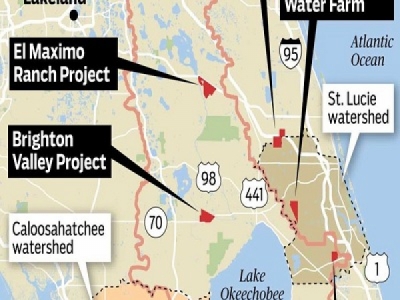
Posted on July 31, 2018
Thriving ranch land in the belly of the Indian Prairie Basin will soon be a pool of nutrient-bombed water as Florida looks at temporary fixes for the algae woes of Lake Okeechobee and the northern estuaries.
The Brighton Valley Project, which was approved this month by the South Florida Water Management District, will take water thick with algae-loving fertilizer and agriculture runoff, clean it, and send it into Lake Okeechobee with 70 percent less phosphorous and 35 percent less nitrogen.
Slated for 8,200 acres of privately-owned land now roamed by Angus cattle, the project will cost $11.5 million, and it will take about a year to complete.
It is the second of six planned public-private water storage and cleaning projects meant to act as quick patches to lessen nutrient levels in Lake Okeechobee and reduce discharges to the St. Lucie and Caloosahatchee estuaries while permanent Everglades restoration projects are underway.
NEW: New satellite image shows blue-green algae down in Lake Okeechobee
The Lake O discharges, which have been intermittent since June 1, are partly blamed for harmful blue-green algae infecting the brackish estuary waterways this summer.
“We think this is a good step forward. It maintains the land, but doesn’t require you to buy the land,” said Martha Musgrove, Florida Wildlife Federation’s southern region director, during a June 12 water district meeting. “You are setting the bar, and the bar has been high, but it’s not so high you can’t jump over it and succeed.”
In 2016, when another algae bloom slimed the Treasure Coast following water releases from Lake Okeechobee, state lawmakers set aside about $48 million for the construction of water projects that partner with private land owners in the northern Everglades.
RELATED: Lake Okeechobee not lone cause Treasure Coast algae
Sixteen proposals were submitted. The Florida Department of Environmental Protection chose six to proceed.
The first, which is on a former citrus grove in Martin County, began as a 413-acre pilot project in 2014 to store excess water instead of having it flush out the St. Lucie Estuary. The Caulkins Water Farm has since grown to a 2-mile-by-3-mile reservoir that stores dirty water from the C-44 Canal with a goal of holding up to 35 billion gallons of water every year.
Plans are for the Caulkins reservoir to store the water and never discharge under normal conditions. About 18 percent evaporates, and 82 percent remains in the 10-foot deep reservoir surrounded by a 17-mile man-made berm.
RELATED: Water on ex-citrus grove reduces Lake O discharges into estuaries
“For 50 years this has been a flourishing, terrific ag property, a citrus grove, but like many other growers, certainly all the commercial growers in Martin County, we were hit by citrus greening and lost all of our trees,” said Caulkins Citrus Co. President George Caulkins III, in a fall interview. “We found a way to repurpose this land … and figure out a way to take lemons and make lemonade, for the citizens of Martin County and the St. Lucie Estuary and the coast.”
At Brighton, which is northwest of Lake Okeechobee in Highlands County, the plan is to pull in water from the C-41 Canal, cycle it through two treatment ponds, and send it out the C-40 Canal into Lake Okeechobee.
RELATED: Lake O algae could reach Palm Beach County; safeguards made to avoid 2016
The land is an upland/wetland mosaic ecosystem, which includes a variety of natural landscape that will filter out nutrients over time. The $11.5 million will pay for berms, pumps and the creation of the two water-cleaning ponds that will range from one to four feet deep.
“It won’t officially reduce the discharges to the estuaries, but the water flowing into the lake will be at a far cleaner rate than today,” said Ansley Marr, the water district’s section administrator for the Northern Everglades.
Landowner Lykes Bros. Inc. will get an estimated $3 million per year to operate the Brighton project for 10 years.
The Lykes family has been in Florida since the 1860s with the company now owning about 330,000 acres of ranch land and citrus groves.
Noah Handley, project manager for Lykes Brighton Valley, said the Lykes Bros. company has two other water storage and treatment projects ongoing with the state.
WEATHER LOVERS: Be in the know with our weekly WeatherPlus newsletter. Sign up now!
“We’ve been working with different folks trying to come up with ideas to get projects up and running faster and economically,” he said. “We want to try and help the ecosystems downstream.”
Florida’s early flood management program meant diverting the natural southern overflow from Lake Okeechobee by dredging canals to the coast to drain land for farms and homes. This robbed the southern Everglades of fresh water.
At the north end of the lake, the Kissimmee River was deepened and straightened, funneling rain, along with heavy loads of phosphorus and nitrogen, straight into Lake Okeechobee.
When the lake gets too high, water needs to be discharged to the Caloosahatchee and St. Lucie estuaries — a move that contributes to the growth of cyanobacteria, or blue-green algae.
“The state is doing its part to finish major restoration projects that will protect the estuaries long-term,” said Federico Fernandez, the water management district’s governing board chairman. “Private landowners are giving us the flexibility needed to store and treat water in the short-term.”
Source: myPalmBeachPost





